Klipsch Reference Sub Handleiding
Bekijk gratis de handleiding van Klipsch Reference Sub (24 pagina’s), behorend tot de categorie Subwoofer. Deze gids werd als nuttig beoordeeld door 81 mensen en kreeg gemiddeld 4.0 sterren uit 41 reviews. Heb je een vraag over Klipsch Reference Sub of wil je andere gebruikers van dit product iets vragen? Stel een vraag
Pagina 1/24

REFERENCE
SUBWOOFERS
OWNER'S MANUAL

REFERENCE SERIES
IMPORTANT SAFETY INSTRUCTIONS
1. READ these instructions.
2. KEEP these instructions.
3. HEED all warnings.
4. FOLLOW all instructions.
5. DO NOT use this apparatus near water.
6. CLEAN ONLY with dry cloth.
7. DO NOT block any ventilation openings. Install in accordance with the manufacturer's
instructions.
8. DO NOT install near any heat sources such as radiators, heat registers, stoves, or other
apparatus (including amplifiers) that produce heat.
9. DO NOT defeat the safety purpose of the polarized or grounding type plug. A polarized plug
has two blades with one wider than the other. A grounding type plug has two blades and a
third grounding prong. The wider blade or the third prong are provided for your safety.
If the provided plug does not fit into your outlet, consult an electrician for replacement of the
obsolete outlet.
10. PROTECT the power cord from being walked on or pinched, particularly at plugs,
convenience receptacles, and the point where they exit from the apparatus.
11. ONLY USE attachments/accessories specified by the manufacturer.
12. USE only with a cart, stand, tripod, bracket, or table specified by the manufacturer, or sold
with the apparatus. When a cart is used, use caution when moving the cart/apparatus
combination to avoid injury from tip-over.
13. UNPLUG this apparatus during lightning storms or when unused for long periods of time.
14. REFER all servicing to qualified service personnel. Servicing is required when the apparatus
has been damaged in any way, such as power-supply cord or plug is damaged, liquid has
been spilled or objects have fallen into the apparatus, the apparatus has been exposed to
rain or moisture, does not operate normally, or has been dropped.
This symbol indicates that there are important operating and maintenance instructions
in the literature accompanying this unit.
This symbol indicates that dangerous voltage constituting a risk of electric shock is
present within this unit.
WARNING: To reduce the risk of fire or electrical shock, do not expose this apparatus to rain
or moisture.
WARNING: Voltages in this equipment are hazardous to life. No user-serviceable parts inside.
Refer all servicing to qualified service personnel.
CAUTION: Changes or modifications not expressly approved by the manufacturer could void the
user’s authority to operate this device.
ABOUT YOUR KLIPSCH PURCHASE
Thank you for your purchase of a Klipsch subwoofer. After reading this manual and connecting
your system, you will hear the result of over 55 years of stringent engineering and class-leading
research and development. Please be sure to fill out the warranty card at the back of this
manual or online at www.klipsch.com so we are better able to serve you. Again, thank you
for choosing Klipsch and we hope that your subwoofer brings life to your music and movies for
many years.
RISK OF ELECTRIC SHOCK
DO NOT OPEN
PLACEMENT
Although your Reference Series subwoofer will perform well in a wide variety of locations, you
will get the most out of it by following some simple guidelines:
•Although the subwoofer’s orientation is not critical, avoid placing the front (driver) side of the
cabinet up against a wall.
• The subwoofer’s output will increase as it is moved closer to walls, with maximum output
achieved when it is placed in a corner. If practical, always place the subwoofer against or
near a wall.
• In most rooms, a subwoofer will deliver smoothest bass response when placed in a corner
away from room openings, such as doors.
• If you are using more than one subwoofer, you will usually achieve the best performance by
placing them together in the same area rather than by spacing them apart.
CONNECTION AND ADJUSTMENT
Make all connections with the power turned off on your subwoofer and main amplifier. Your
subwoofer has three sets of input connections on its back panel: (1) a single LFE-Direct RCA
jack that bypasses the internal crossover; (2) a pair of RCA jacks for line-level stereo (or mono)
input; and (3) a set of terminals for connection to speaker outputs on a receiver or amplifier. In
addition, there are four controls on the back panel: (1) Main Power; (2) Auto Power On/Off;
(3) Phase; and (4) Lowpass Crossover Frequency. The Volume Level control is located on the
upper right side panel of the subwoofer.
Digital Surround Receiver or Processor Connection — Today’s Dolby Digital
®(AC-3) and
DTS®digital surround receivers and processors have line-level subwoofer outputs and built-in
subwoofer crossovers. If your system is built around one of these, it will almost always be best
to connect the subwoofer output on the receiver or processor to the subwoofer’s LFE Direct
input. (See Figure 1.) This will bypass the subwoofer’s internal crossover and should only be
done if these can be managed internally in the receiver. Use a shielded, high quality subwoofer
interconnect cable of appropriate length with RCA plugs on each end. Your dealer can help you
select a suitable cable. Be sure to go into your receiver or processor’s speaker setup menu
and set Subwoofer to "On" or "Yes." Your receiver or processor may have additional bass man-
agement abilities beyond simply activating the subwoofer output. Consult your receiver or
processor’s owner’s manual or your dealer for more information on the proper bass manage-
ment settings for your system.
Power — Set the subwoofer’s Main Power switch to "Off." Then plug the power cord into an
AC outlet. You can turn the power on and off manually using the switch, or you can leave the
Main Power turned on and set the Auto Power switch to "On," which will automatically turn the
subwoofer on when a signal is detected at one of the inputs and off after a period of inactivity.
We recommend Auto Power "On" for most systems.
Figure 1
ENGLISH

Crossover Adjustment — Using the LFE Direct input bypasses the Crossover Frequency
control on the back panel. Your receiver or processor will handle the crossover function. Most use
a single, set frequency between 80Hz and 100Hz. If your receiver or processor gives you a
choice of crossover frequencies, 80Hz is usually a good starting point. Refer to the adjustment
section for more information. In that case, start with the frequency that comes closest to match-
ing the specified low-frequency limit of the smallest speakers in the system. After completing the
other adjustments, you may want to experiment with moving the frequency up and down a little,
to see if a different setting works slightly better. If the crossover frequency is set higher than
100Hz, the subwoofer should be in the front of the room near the front main speakers.
Volume Control — Adjust the subwoofer’s Level to get a smooth transition between its output
and that of the main speakers. Your receiver or processor will have a subwoofer level control in
its speaker setup menu, so you will have to go back and forth a bit between it and the Level
control on the subwoofer itself. In the end, you should wind up with the menu control somewhere
in the middle of its range. Strive for bass that is solid but not overblown or boomy.
Phase Control — In some installations the setting of the Phase Control may not make much
difference, whereas in others it may be necessary to go back and forth between the Phase and
the Level controls for a while in order to get the very best blend with the main speakers. Since
each control setting (including the one for crossover frequency in the receiver or processor)
affects the optimum settings for the others, it often takes a while to get everything dialed in just
right. Start with the phase knob at 0° and play a recording with a prominent, repeating bass line
in your listening position. Repeat this process with the control in the 90° and 180° positions. Use
the setting that yields the greatest bass output.
Analog Surround Receiver / Processor or Two-Channel Stereo System Connection —
Some analog A/V receivers and processors (without Dolby Digital®or DTS®capability) have a
line-level subwoofer output. Others have left- and right-channel line-level outputs, as do some
stereo receivers and integrated amplifiers. All separate stereo preamps and surround processors
have line-level outputs. These outputs can be connected to your subwoofer’s main line-level
inputs. (See Figure 2.) You will need one or two shielded, high quality interconnect cables of
appropriate length with RCA plugs on each end. Your dealer can help you select suitable cables.
If your system does not provide any of these outputs, you will need to connect the subwoofer’s
Speaker Level inputs to your receiver or integrated amplifier’s speaker outputs. (See Figure 3.)
• Subwoofer Output — Connect the subwoofer output jack to one of the line-level input jacks
on the subwoofer. Do not use the LFE Direct input.
• Preamp Outputs on Receiver or Integrated Amplifier — If your receiver or integrated
amplifier has spare preamplifier outputs for its front left and right channels, connect these to
the line-level input jacks on the subwoofer.
• Pre-out/Main-in Loops on Receiver or Integrated Amplifier — Some receivers and
integrated amplifiers have their preamplifier and power amplifier stages connected externally
via jumpers. If yours has its left and right front channels connected this way, you can connect
your subwoofer to those preamp outputs. You will need a pair of Y-adaptors, each with two
male RCA plugs and one female RCA jack. Remove the jumpers for the two channels. For
each, plug one leg of a Y-adaptor into the preamp output jack and another into the main amp
input jack. Plug the cables leading to the subwoofer into the female ends of the Y-adaptors.
ON
OFF
T2A 250V
120V~60Hz 2A
LEFT RIGHT
HIGH LEVEL
IN
+
–
POWER
AUTO
POWER
ON OFF
PHASE
LOWPASS
(Hz)
LINE
IN
LFE
R L
0˚
90˚
180˚
40
70 100
120
SUB AMP PANEL
RECEIVER
LINE LEVEL OUT
R L
Figure 2
ENGLISH
•Separate Preamplifier or Surround Processor — You will need a pair of Y-adaptors, each with
one male RCA plug and two female RCA jacks. Unplug the cables leading from the front left- and
right-channel outputs on the preamp or processor and plug the Y-adaptors into them. For each
channel, plug the cable leading to the power amplifier into one of the RCA jacks on the Y-adaptor
and the cable leading to the subwoofer into the other.
•Speaker Outputs — Connect the subwoofer’s Speaker Level inputs to the same outputs on your
receiver or integrated amplifier as your front left and right speakers. This involves running a
second set of wires from the left and right speaker outputs to the subwoofer. Maintain
correct polarity, with positive (+, red) outputs connected to the positive inputs and negative
(–, black) outputs connected to the negative inputs. Make sure that there is no metal-to-metal
contact between the positive and negative sides of either connection at either end. Failure to
observe this precaution can result in amplifier malfunction or damage. The subwoofer can be
connected to a secondary or “B” main channel output of your apmplifier if the volume of your
main speakers is unaffected when both outputs are selected.
Power — Set the subwoofer’s Main Power switch to "Off." Then plug the power cord into an AC
outlet. You can turn the power on and off manually using the switch, or you can leave the Main
Power turned on and set the Auto Power switch to "On," which will automatically turn the
subwoofer on when a signal is detected at one of the inputs and off after a period of inactivity. We
recommend Auto Power "On" for most systems.
Adjustment — Start by setting the Crossover Frequency control to the approximate low-frequency
limit of your main left and right front speakers. If you don’t have their specifications, take an
educated guess based on the size of the speakers. A large speaker will usually work down to lower
frequencies than a small speaker. So for a large floorstanding loudspeaker, you might start with the
Crossover Frequency set all the way down to 40Hz, whereas for very small satellite speakers you
might want to turn it all the way up to 120Hz. Typical bookshelf speakers would tend to be in the
50Hz to 80Hz range. If the crossover frequency is set higher than 100Hz, the subwoofer should be
in the front of the room near the front main speakers.
Play a variety of music recordings containing strong but not overpowering bass. Adjust the sub-
woofer’s Level control until the music sounds consistently warm and natural. If you have trouble
getting enough low bass without the sound becoming boomy, it probably means the Crossover
Frequency is set too high. Try turning it down a bit at a time until the problem goes away. If the
sound is thin until you turn the subwoofer Level up so much that the lower bass is too prominent,
start by varying the setting of the Phase control. If that does not entirely solve the problem, you
probably need to raise the Crossover Frequency.
General Comment About Adjustments: Since any change in the setting of one control tends to
change the optimum settings for the others to some degree, the adjustment process is very interac-
tive and involves a great deal of trial and error. If after a period of listening and calibration you’re
still not happy, it may mean that you need to experiment a little with the location of the subwoofer.
That, of course, also interacts with everything else. Again, patience is a virtue. The end result will be
well worth the effort.
CARE AND CLEANING
The only thing you should ever need to do to your subwoofer is to dust it occasionally. Never apply
any abrasive or solvent-based cleaner or any harsh detergent. You can clean the grille with the
brush attachment of a vacuum cleaner.
ON
OFF
T2A 250V
120V~60Hz 2A
LEFT RIGHT
HIGH LEVEL
IN
+
–
POWER
AUTO
POWER
ON OFF
PHASE
LOWPASS
(Hz)
LINE
IN
LFE
R L
0˚
90˚
180˚
40
70 100
120
SUB AMP PANEL
RECEIVER
STEREO OUT
R L
+
–
Figure 3
SPEAKER
Product specificaties
| Merk: | Klipsch |
| Categorie: | Subwoofer |
| Model: | Reference Sub |
Heb je hulp nodig?
Als je hulp nodig hebt met Klipsch Reference Sub stel dan hieronder een vraag en andere gebruikers zullen je antwoorden
Handleiding Subwoofer Klipsch
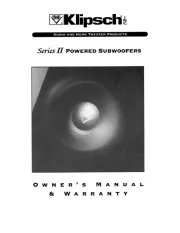
5 Juli 2025

16 Juni 2025
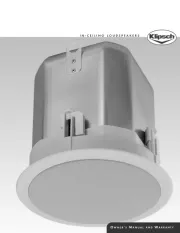
1 Mei 2025
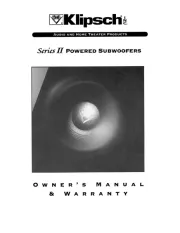
2 April 2025
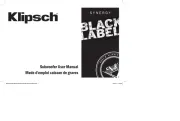
2 April 2025
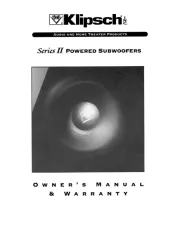
2 April 2025
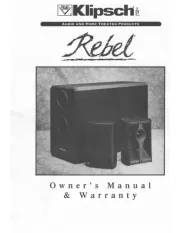
2 April 2025

19 Februari 2025

19 Februari 2025
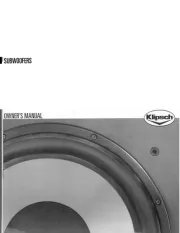
19 Februari 2025
Handleiding Subwoofer
- Q Acoustics
- Kanto
- PreSonus
- Alphasonik
- Alto
- Amina
- Power Acoustik
- PrecisionPower
- NEAR
- SSV Works
- H YANKA
- Kicker
- Bowers And Wilkins
- Cerwin-Vega
- Sony
Nieuwste handleidingen voor Subwoofer
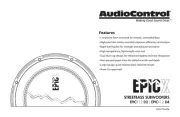
29 Juli 2025
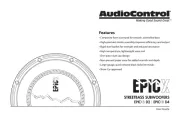
29 Juli 2025
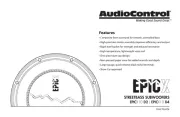
29 Juli 2025

24 Juli 2025

24 Juli 2025

21 Juli 2025

21 Juli 2025
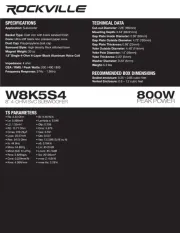
15 Juli 2025
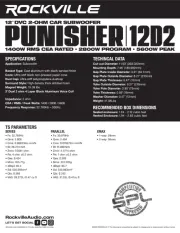
15 Juli 2025
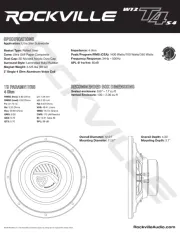
15 Juli 2025